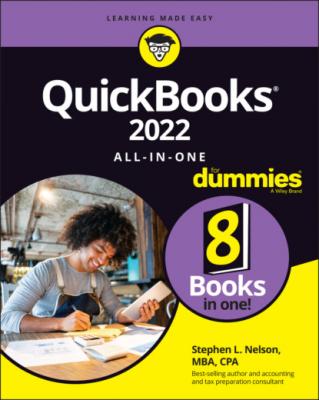QuickBooks 2022 All-in-One For Dummies. Stephen L. Nelson
Чтение книги онлайн.
Читать онлайн книгу QuickBooks 2022 All-in-One For Dummies - Stephen L. Nelson страница 15
 should also mention one final thing: Accounting software programs require you to do a certain amount of preparation before you can use them to get real work done. If you haven’t started to use QuickBooks yet, I recommend that you skim Book 1 and then read Book 2 to find out what you need to do first.
should also mention one final thing: Accounting software programs require you to do a certain amount of preparation before you can use them to get real work done. If you haven’t started to use QuickBooks yet, I recommend that you skim Book 1 and then read Book 2 to find out what you need to do first.
Book 1
An Accounting Primer
Contents at a Glance
1 Chapter 1: Principles of Accounting The Purpose of Accounting Reviewing the Common Financial Statements The Philosophy of Accounting A Few Words about Tax Accounting
2 Chapter 2: Double-Entry Bookkeeping The Fiddle-Faddle Method of Accounting How Double-Entry Bookkeeping Works Almost a Real-Life Example A Few Words about How QuickBooks Works
3 Chapter 3: Special Accounting Problems Working with Accounts Receivable Recording Accounts Payable Transactions Inventory Accounting Accounting for Fixed Assets Recognizing Liabilities Closing Out Revenue and Expense Accounts One More Thing …
Chapter 1
Principles of Accounting
IN THIS CHAPTER
Any discussion of how to use QuickBooks to manage your business better begins with a discussion of the basics of accounting. For this reason, in this chapter and the next two, I attempt to provide the same information that you’d receive in an introductory college accounting course. I tailor the entire discussion, of course, to QuickBooks and the small-business environment. What you’ll read about here and in the next two chapters of this minibook pretty much describes how accounting works in a small-business setting when you’re using QuickBooks.
If you’ve had some experience with accounting, if you know how to read an income statement and balance sheet, or if you know how to construct a journal entry, you don’t need to read this chapter or the next ones. But if you’re new to accounting and business bookkeeping, take the time to read this chapter carefully. I start by giving you a high-level overview of the purpose of accounting. Then I review the common financial statements that any accounting system worth its salt produces. I also discuss some of the important principles of accounting and the philosophy of accounting. Finally, I talk a little bit about income tax law and tax accounting.
The Purpose of Accounting
In the movie Creator, Peter O’Toole plays an eccentric professor. At one point, O’Toole’s character attempts to talk a young student into working as an unpaid research assistant. When the student protests, noting that he needs 15 credit hours, O’Toole creates a special 15-credit independent-study course named “Introduction to the Big Picture.” In the next section, I describe the “big picture” of accounting. At its core, accounting makes perfect, logical sense.
The big picture
The most important thing to understand about accounting is that it provides financial information to stakeholders. Stakeholders are the people who do business with or interact with a firm; they include managers, employees, investors, banks, vendors, government authorities, and agencies that may tax a firm. Stakeholders and their information requirements deserve a bit more discussion. Why? Because the information needs of these stakeholders determine what an accounting system must do.
Managers, investors, and entrepreneurs
The first category of stakeholders includes the firm’s managers, investors, and entrepreneurs. This group needs financial information to determine whether a business is making money. This group also wants any information that gives insight into whether a business is growing or contracting and how healthy or sick it is. To fulfill its obligations and duties, this group often needs detailed information. A manager or entrepreneur may want to know which customers are particularly profitable — or unprofitable. An active investor may want to know which product lines are growing or contracting.
A related set of information requirements concerns asset and liability record keeping. An asset is something that the firm owns, such as cash, inventory, or equipment. A liability is some debt or obligation that the firm owes, such as bank loans and accounts payable.
Obviously, someone at a firm — perhaps a manager, bookkeeper, or accountant — needs to have very detailed records of the amount of cash that the firm has in its bank accounts, the inventory that the firm has in its warehouse or on its shelves, and the equipment that the firm owns and uses in its operations.
If you look over the preceding two or three paragraphs, nothing I’ve said is particularly surprising. It makes sense, right? Someone who works in a business, manages a business, or actively invests in a business needs good general information about the financial affairs of the firm and, in many cases, very detailed information about important assets (such as cash) and liabilities (such as bank loans).
External creditors
A